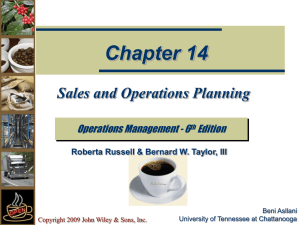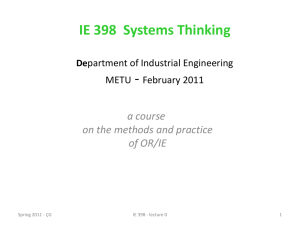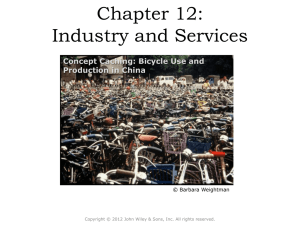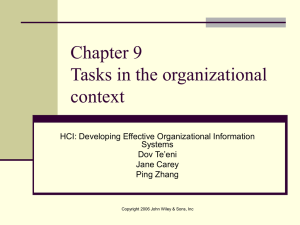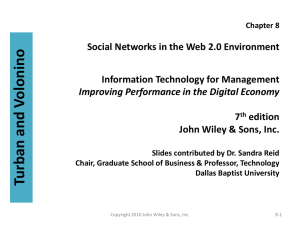Chapter 10 Supply Chain Management
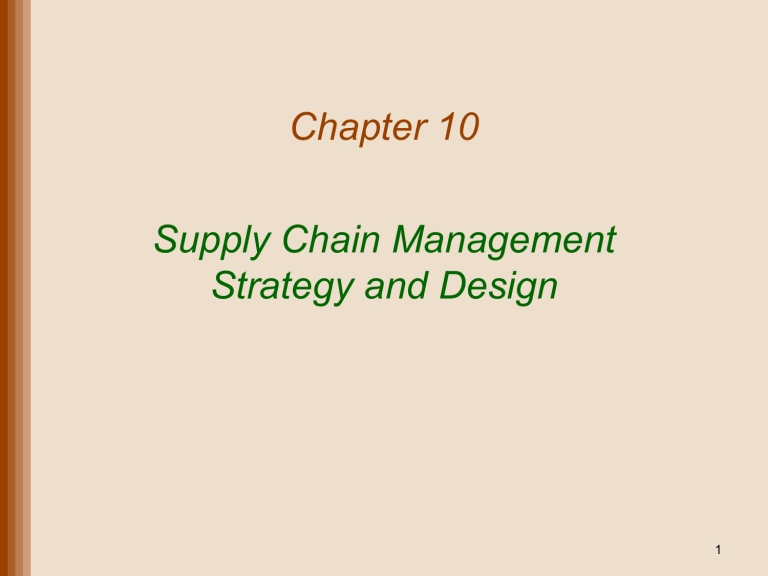
Chapter 10
Supply Chain Management
Strategy and Design
1
Lecture Outline
• The Management of Supply Chains
• Green Supply Chains
• Information Technology: A Supply Chain Enabler
• Supply Chain Integration
• Supply Chain Management (SCM) Software
• Measuring Supply Chain Performance
Copyright 2011 John Wiley & Sons, Inc.
10-2
Supply Chains
• All facilities, functions, and activities associated with flow and transformation of goods and services from raw materials to customer, as well as the associated information flows
• An integrated group of processes to “source,”
“make,” and “deliver” products
Copyright 2011 John Wiley & Sons, Inc.
10-3
The Supply Chain – Figure10.1
Copyright 2011 John Wiley & Sons, Inc.
10-4
Supply Chain for Denim Jeans
Figure 10.2a
Copyright 2011 John Wiley & Sons, Inc.
10-5
Supply Chain for Denim Jeans (cont.)
Figure 10.2b
Copyright 2011 John Wiley & Sons, Inc.
10-6
Supply Chain Processes
Copyright 2011 John Wiley & Sons, Inc.
10-7
Supply Chain for Service Providers
• More difficult than manufacturing
• Does not focus on the flow of physical goods
• Focuses on human resources and support services
• More compact and less extended
Copyright 2011 John Wiley & Sons, Inc.
10-8
Value Chains
• Value chain
• every step from raw materials to the eventual end user
• ultimate goal is delivery of maximum value to the end user
• Supply chain
• activities that get raw materials and subassemblies into manufacturing operation
• ultimate goal is same as that of value chain
Copyright 2011 John Wiley & Sons, Inc.
10-9
Value Chains
• Demand chain
• increase value for any part or all of chain
• Terms are used interchangeably
• Value
• creation of value for customer is important aspect of supply chain management
Copyright 2011 John Wiley & Sons, Inc.
10-10
Supply Chain Management (SCM)
• Managing flow of information through supply chain in order to attain the level of synchronization that will make it more responsive to customer needs while lowering costs
• Keys to effective SCM
• information
• communication
• cooperation
• trust
Copyright 2011 John Wiley & Sons, Inc.
10-11
Supply Chain
Uncertainty and Inventory
• A major objective of SCM:
• respond to uncertainty in customer demand without creating costly excess inventory
• Negative effects of uncertainty
• lateness
• incomplete orders
• Inventory
• insurance against supply chain uncertainty
Copyright 2011 John Wiley & Sons, Inc.
10-12
Supply Chain
Uncertainty and Inventory
• Factors that contribute to uncertainty
• inaccurate demand forecasting
• long variable lead times
• late deliveries
• incomplete shipments
• product changes
• batch ordering
• price fluctuations and discounts
• inflated orders
Copyright 2011 John Wiley & Sons, Inc.
10-13
Bullwhip Effect
• Occurs when slight demand variability is magnified as information moves back upstream
Copyright 2011 John Wiley & Sons, Inc.
10-14
Risk Pooling
• Risks are aggregated to reduce the impact of individual risks
• Combine inventories from multiple locations into one
• Reduce parts and product variability, thereby reducing the number of product components
• Create flexible capacity
Copyright 2011 John Wiley & Sons, Inc.
10-15
“Green” Supply Chains
• Sustainability
• Meeting present needs without compromising the ability of future generations to meet their needs
• Sustaining human and social resources
• It can be cost effective and profitable
• Can provide impetus for product and process innovations
• Impetus comes from downstream in the supply chain and moves upstream to suppliers
Copyright 2011 John Wiley & Sons, Inc.
10-16
Sustainability and Quality Management
• Reducing waste through quality programs helps achieve sustainability goals
• Improving fuel efficiency of vehicles
• Telecommuting
• Eco-friendly packing materials
• Energy-efficient facilities
Copyright 2011 John Wiley & Sons, Inc.
10-17
Information Technology:
A Supply Chain Enabler
• Information links all aspects of supply chain
• E-business
• replacement of physical business processes with electronic ones
• Electronic data interchange (EDI)
• a computer-to-computer exchange of business documents
• Bar code and point-of-sale
• data creates an instantaneous computer record of a sale
Copyright 2011 John Wiley & Sons, Inc.
10-18
IT: Supply Chain Enabler
• Radio frequency identification (RFID)
• technology can send product data from an item to a reader via radio waves
• Internet
• allows companies to communicate with suppliers, customers, shippers and other businesses around the world instantaneously
• Build-to-order (BTO)
• direct-sell-to-customers model via the Internet; extensive communication with suppliers and customer
Copyright 2011 John Wiley & Sons, Inc.
10-19
Supply Chain Enablers
Copyright 2011 John Wiley & Sons, Inc.
10-20
E-Business & Supply Chain Management
• Savings due to lower transaction costs
• Reduction of intermediary roles
• Shorter supply chain response times
• Wider presence and increased visibility
• Greater choices & more info for customers
• Improved service
• Collection & analysis of huge amounts of customer data & preferences
• Access to global markets, suppliers & distribution channels
Copyright 2011 John Wiley & Sons, Inc.
10-21
Electronic Data Interchange
• Computer-to-computer exchange of documents in a standard format
• Purchasing, shipping and receiving
• Improve customer service
• Reduce paperwork
• Increase productivity
• Improve billing and cost efficiency
• Reduce bullwhip effect through information sharing
Copyright 2011 John Wiley & Sons, Inc.
10-22
Bar Codes
• Automated data collection system
• Bar code contains identifying information
• Provide instantaneous tracking information
• Checkout scanners create point-of-sale data
• Update inventory records
• Identify trends
• Order material
• Schedule orders
• Plan deliveries
Copyright 2011 John Wiley & Sons, Inc.
10-23
Radio Frequency Identification (RFID)
• Use radio waves to transfer data from chip to a reader
• Provides complete visibility of product location
• Continuous inventory monitoring
• Reduce labor to manage inventory
• Reduce inventory costs
• RFID is not standardized yet
• Difficult to track between systems
Copyright 2011 John Wiley & Sons, Inc.
10-24
RFID Capabilities
Copyright 2011 John Wiley & Sons, Inc.
10-25
RFID Capabilities
Copyright 2011 John Wiley & Sons, Inc.
10-26
Supply Chain Integration
• Share information among supply chain members
• Reduced bullwhip effect
• Early problem detection
• Faster response
• Builds trust and confidence
• Collaborative planning, forecasting, replenishment, and design
• Reduced bullwhip effect
• Lower costs (material, logistics, operating, etc.)
• Higher capacity utilization
• Improved customer service levels
Copyright 2011 John Wiley & Sons, Inc.
10-27
Supply Chain Integration
• Coordinated workflow, production and operations, procurement
• Production efficiencies
• Fast response
• Improved service
• Quicker to market
• Adopt new business models and technologies
• Penetration of new markets
• Creation of new products
• Improved efficiency
• Mass customization
Copyright 2011 John Wiley & Sons, Inc.
10-28
Collaborative Planning, Forecasting, and Replenishment (CPFR)
• Two or more companies in a supply chain to synchronize their demand forecasts into a single plan to meet customer demand
• Parties electronically exchange
• past sales trends
• point-of-sale data
• on-hand inventory
• scheduled promotions
• forecasts
Copyright 2011 John Wiley & Sons, Inc.
10-29
SCM Software
• Enterprise resource planning (ERP)
• software that integrates the components of a company by sharing and organizing information and data
Copyright 2011 John Wiley & Sons, Inc.
10-30
Measuring Supply Chain Performance
• Metrics used to measure supply chain performance
•Inventory turnover
Inventory turns
Cost of goods sold
Average aggregate value of inventory
•Total value (at cost) of inventory
Average aggregate value of inventory
(average inventory for item i )
(unit valu e item i )
Copyright 2011 John Wiley & Sons, Inc.
10-31
Measuring Supply Chain Performance
•Days of supply
Days of supply
Average aggregate value of inventory
(Cost of goods sold)/(365 days)
•Fill rate: fraction of orders filled by a distribution center within a specific time period
Copyright 2011 John Wiley & Sons, Inc.
10-32
Computing Key Performance Indicators
Copyright 2011 John Wiley & Sons, Inc.
10-33
Process Control and SCOR
• Process Control
• not only for manufacturing operations
• can be used in any processes of supply chain
• Supply Chain Operations Reference (SCOR)
• a cross industry supply chain diagnostic tool maintained by the Supply Chain Council
Copyright 2011 John Wiley & Sons, Inc.
10-34
SCOR Model Processes
Copyright 2011 John Wiley & Sons, Inc.
10-35
SCOR Performance Metrics
Copyright 2011 John Wiley & Sons, Inc.
10-36
Copyright 2011 John Wiley & Sons, Inc.
All rights reserved. Reproduction or translation of this work beyond that permitted in section 117 of the 1976
United States Copyright Act without express permission of the copyright owner is unlawful. Request for further information should be addressed to the Permission
Department, John Wiley & Sons, Inc. The purchaser may make back-up copies for his/her own use only and not for distribution or resale. The Publisher assumes no responsibility for errors, omissions, or damages caused by the use of these programs or from the use of the information herein.
Copyright 2011 John Wiley & Sons, Inc.
10-37

